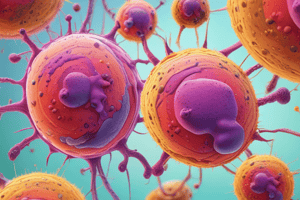Podcast
Questions and Answers
According to the updated Koch's Molecular Postulates, what is one of the criteria in identifying the gene responsible for virulence?
According to the updated Koch's Molecular Postulates, what is one of the criteria in identifying the gene responsible for virulence?
- The gene might not cause a specific immune response.
- The gene must be absent in disease-causing strains.
- The gene should not be expressed in vivo.
- The gene must be present in avirulent strains. (correct)
Which stage of the disease process involves further growth at original or other sites?
Which stage of the disease process involves further growth at original or other sites?
- Attachment and Invasion
- Tissue damage and disease
- Colonisation and Damage
- Invasiveness (correct)
What type of transmission involves passing a communicable disease from an infected host to a particular individual or group?
What type of transmission involves passing a communicable disease from an infected host to a particular individual or group?
- Horizontal transmission (correct)
- Vehicle-borne transmission
- Vector-borne transmission
- Vertical transmission
In the disease process, what happens during the stage of skin/mucosa adherence?
In the disease process, what happens during the stage of skin/mucosa adherence?
Which type of transmission involves passing a communicable disease through another organism?
Which type of transmission involves passing a communicable disease through another organism?
What is a key step in confirming the gene responsible for virulence according to Koch's Molecular Postulates?
What is a key step in confirming the gene responsible for virulence according to Koch's Molecular Postulates?
Which factor plays an important role in the successful exposure of a disease?
Which factor plays an important role in the successful exposure of a disease?
What is the significance of biofilms in infections?
What is the significance of biofilms in infections?
Which of the following is NOT a factor that influences successful exposure to diseases?
Which of the following is NOT a factor that influences successful exposure to diseases?
What is the main consequence of microbial toxins on host tissues?
What is the main consequence of microbial toxins on host tissues?
How do bacteria avoid host defenses during attachment and invasion?
How do bacteria avoid host defenses during attachment and invasion?
What is the role of receptors on host cells in the transmission of diseases?
What is the role of receptors on host cells in the transmission of diseases?
Which of the following is NOT a type of microbial exotoxin based on its effect?
Which of the following is NOT a type of microbial exotoxin based on its effect?
What role do Type I Superantigens play in host cells?
What role do Type I Superantigens play in host cells?
Which statement accurately describes the role of vectors in disease transmission?
Which statement accurately describes the role of vectors in disease transmission?
Which bacterial pathogen produces Toxin A (enterotoxin) and Toxin B (cytotoxin)?
Which bacterial pathogen produces Toxin A (enterotoxin) and Toxin B (cytotoxin)?
Which type of microbial toxin affects cells lining the gastrointestinal tract?
Which type of microbial toxin affects cells lining the gastrointestinal tract?
What is the primary role of animals in infectious diseases according to the text?
What is the primary role of animals in infectious diseases according to the text?
Which occupation is traditionally mentioned as being at a higher risk of infectious disease exposure due to close contact with animals or animal products?
Which occupation is traditionally mentioned as being at a higher risk of infectious disease exposure due to close contact with animals or animal products?
Which phenomenon involves the combination of two or more different strains of a virus to produce a new form with a mixture of surface antigens?
Which phenomenon involves the combination of two or more different strains of a virus to produce a new form with a mixture of surface antigens?
What are Koch's postulates primarily used for in infectious disease research?
What are Koch's postulates primarily used for in infectious disease research?
Which infectious disease is mentioned as having proof available following Koch's postulates?
Which infectious disease is mentioned as having proof available following Koch's postulates?
What is a major risk factor for infectious disease transmission highlighted in the text?
What is a major risk factor for infectious disease transmission highlighted in the text?
Which of the following non-bacterial diseases is known to be persistent and can be localised or systemic?
Which of the following non-bacterial diseases is known to be persistent and can be localised or systemic?
Which non-bacterial disease is commonly caused by the species of Trichophyton, Epidermophyton, and Microsporum?
Which non-bacterial disease is commonly caused by the species of Trichophyton, Epidermophyton, and Microsporum?
Which viral disease can lead to human breast cancer according to the provided text?
Which viral disease can lead to human breast cancer according to the provided text?
What type of disease can be caused by Mycoses as mentioned in the text?
What type of disease can be caused by Mycoses as mentioned in the text?
Which viral disease is classified as a communicable disease according to the text?
Which viral disease is classified as a communicable disease according to the text?
Athlete's foot, Thrush, and Aspergillosis are examples of diseases that are caused by which type of pathogens as per the text?
Athlete's foot, Thrush, and Aspergillosis are examples of diseases that are caused by which type of pathogens as per the text?
Flashcards are hidden until you start studying




